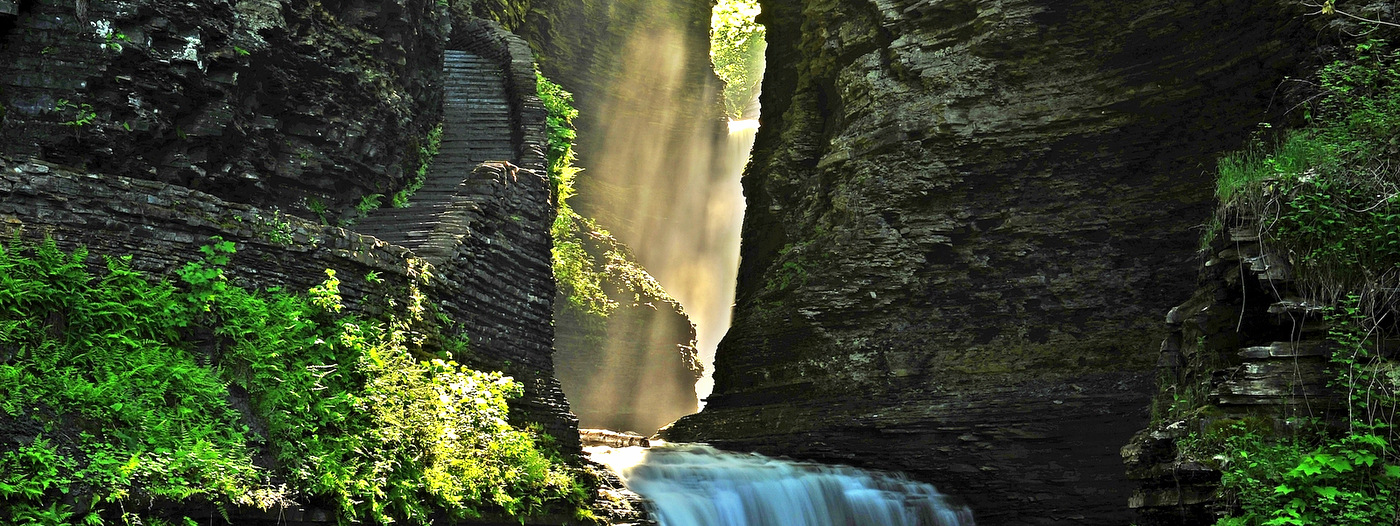Top Gorge Hikes in the Finger Lakes
Gorges—those narrow, sinuous openings in the landscape that often reveal eons of geological activity. They also make for fascinating and vigorous hikes! There is much to appreciate on a trek through one of our region’s iconic gorges: dazzling waterfalls, beautiful stonework, flowing streams, and a variety of plants and wildlife. Many gorge hikes and their associated rim trail routes can be adjusted for longer or shorter treks, depending on preference. If you’re looking for a quintessential Finger Lakes adventure, check out one of these gorge hikes chosen by the staff at the Finger Lakes Land Trust.

Robert H. Treman State Park
A marvelous way to experience the gorge at Treman State Park is to walk up the Gorge Trail and then climb down the long stone staircase along the Rim Trail. The 115-foot Lucifer Falls is clearly central, and the handsome stonework winding up along the sheer cliff is equally remarkable. Like many state parks, the beautiful work done by the Civilian Conservation Corps can be admired for its appearance but also in the feat of constructing the trail which literally clings to the cliff. A beautiful stretch of the Finger Lakes Trail (FLT) runs through the park, and hikers can follow the FLT beyond Treman to Lick Brook Gorge and then all the way to Buttermilk Falls State Park.

Watkins Glen State Park
There is no place more iconic of the Finger Lakes waterfall and gorge experience than Watkins Glen State Park. Stunning waterfalls, dramatic flumes, and picturesque potholes combine to make a gorgeous waterscape. The scene is further enhanced by handsome stone staircases, arched bridges, and winding tunnels that weave up and through the scenic gorge. The trail through the gorge is an awe-inspiring confluence of water’s persistent and powerful stone sculpting and a thoughtful merger of human craftsmanship.

Letchworth State Park
A lot of places claim to be the Grand Canyon of the East, and while none truly compare in terms of scale, Letchworth State Park’s grandeur and unique opportunities make it a can’t-miss natural wonder. The park and its rich history encompass seventeen miles of staggeringly sheer gorge, three towering and broad waterfalls, dozens of smaller waterfalls, and 66 miles of trails. There is a greater quantity of trails on the western side of the gorge, leading to scenic overlooks with panoramic views. Hikers have a lot of options at Letchworth, and can even plan overnight or multi-night backpacking trips.

High Tor Wildlife Management Area
Opportunities abound for all types of outdoor enthusiasts at the High Tor Wildlife Management Area, including creek walking and gorge exploration in Conklin Gully-Parish Glen and Clark Gully. Conklin Gully is a recent addition to the WMA, with trails that follow the rim and have several stunning scenes of the gorge and Angel Falls. The more adventurous and sure-of-foot can creek-walk the gorge. Expect to get your feet wet along this unmarked scramble and be cautious of slippery and high water conditions.

Taughannock Falls State Park
The gorge at Taughannock Falls is perhaps more accurately described as a canyon and its namesake waterfall is one of the tallest in New York State. But the falls are not the only impressive aspect of the park. The Rim Trail that encircles the lower and upper gorges provides stunning views down into the canyon. And many will find the history of how the long, broad gorge was formed to be equally impressive while walking through the canyon and viewing the 400-foot-high gorge walls.

Fillmore Glen State Park
In the quiet village of Moravia is another beautiful gorge park — Fillmore Glen. After an initial climb, the Gorge Trail here is relatively flat and easily negotiated. Further along are several stunning smaller cascades and waterfalls that culminate with the tallest falls, Dalibarda Falls, followed shortly after by Upper and Lower Pinnacle Falls. Autumn is a notably beautiful time to visit, either when the leaves are emblazoned with contrasting colors or just after fallen leaves reveal parts of the gorge previously hidden from view by the dense understory.

Cascadilla Gorge Trail
Connective corridors are typically parks or natural areas that connect two distinct areas within a community—for example, separate neighborhoods or villages. Within the heart of Ithaca, there is no better example than Cascadilla Gorge. It is a stunningly beautiful connective corridor that runs from downtown to the Cornell campus. The gorge is a short three-quarters of a mile in length, but it is long on amazing waterscapes.
Other places to explore…

Buttermilk Falls State Park
Located just on the southern edge of Ithaca, Buttermilk Falls is a wildly popular spot for tourists and local residents, especially during the height of summer. Open from early May to early November, the Gorge Trail delights hikers with a picturesque interweaving of landscape and waterscape. In addition to stunning waterfalls, there are innumerable small flumes, tumbles, and cascades that contribute to the awesome scene.

Grimes Glen Park
Formed by gushing meltwaters at the end of the last ice age, Grimes Glen is typical of many Finger Lakes gorges that still carry runoff from uplands down into the ice-carved valleys below. Two stunning 60-foot falls are accessible today by wandering upstream ½ mile or slightly more from the parking area. Waterfall sightseers should expect to get their feet wet since the gorge narrows upstream to a point where there is no streambank.

Lick Brook Gorge
Sweedler and Thayer Preserves, owned by the Finger Lakes Land Trust, along with the adjacent 27-acre Lick Brook Natural Area owned by Cornell University, provide excellent examples of the area’s geologic history and ecological systems. The perpetual protection of this area allows ample opportunity for hiking, including access to Buttermilk Falls State Park via a spur of the Finger Lakes Trail, and peaceful enjoyment of our natural world, while protecting the water quality of Cayuga Lake.





